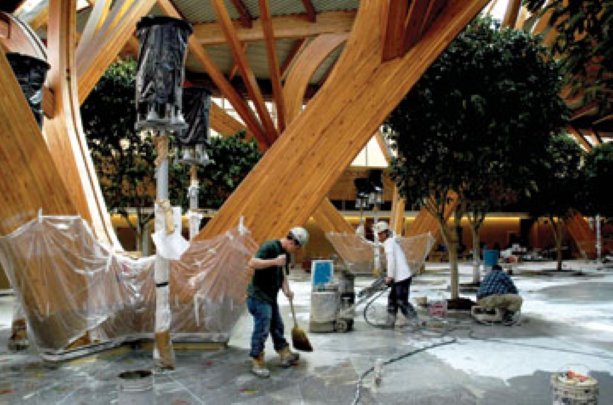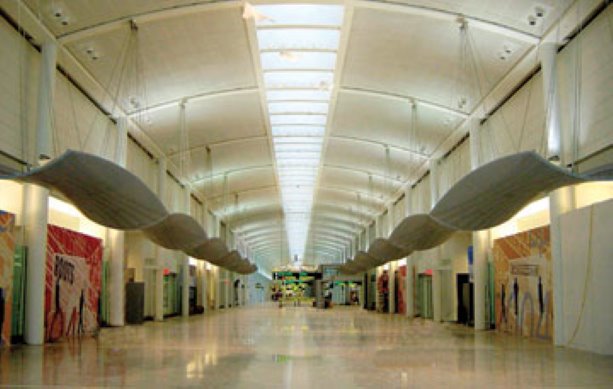When York Marble, Tile and Terrazzo Inc. was founded in 1948, terrazzo was often the material of choice for flooring in hotels, hospitals, schools and other public buildings. Composed of marble, granite, or glass in a cementitious binder, the longevity of the material is nearly unparalleled and maintenance is relatively painless.
“One great thing about terrazzo is the fact that your work is always going to leave a living resumé behind,” says Glen Pesterin, owner of the company. “The heyday for terrazzo was the infrastructure boom of the 1950s through 1970s. We laid the terrazzo floors in many of Toronto’s original subway stations in the 1950s and 1960s and those floors are still in great shape today.”
Pesterin’s father originally co-founded Gem Campbell, a Toronto stone, tile and terrazzo contracting company where Pesterin received his early terrazzo education. His father eventually sold the business, and Pesterin purchased York 13 years ago.
Terrazzo’s rival during the infrastructure boom was quarry tile, a manufactured product made from clay or shale.
“They hadn’t really perfected it then,” says Pesterin. “Although it was heavy-duty, and used in factory and food processing plants, it was limited in terms of custom sizes and colours.”
However, with the advent of cheaper mass-manufactured tiles through the 1970s, terrazzo simply became another flooring choice available to project owners.
Early terrazzo projects all used cementitious binders and metal strips to separate terrazzo sections. The 1970s saw the advent of epoxy binders, which changed application methods.
“With the epoxy binders used today, the product is more flexible and can be applied thinner,” says Pesterin. “It also doesn’t require as many divider strips as the cement method. Designers like it because you can pick a paint colour for the walls and provide an exact match in the terrazzo.”
The grinding process has also evolved. Initially floor grinding was performed using cylindrical silicon carbide grinding plugs, two inches in diameter and two inches thick.
“That process was also messy because it used a lot of water,” says Pesterin. “We’ve replaced that with a drier diamond-grinding process that quickly recaptures the slurry, reducing water use by 70 per cent.”
Some of York’s more recent work can be seen in Osgoode Hall, Fallsview Casino, and the restored Summerhill-North Toronto CPR Station LCBO outlet. However, Pesterin notes that the current terrazzo market fluctuates heavily from year to year. Business is driven in large part by a combination of signature projects and smaller contracts.
“When we were part of a joint venture that did 300,000 square feet of Terminal 1 at Pearson International Airport, terrazzo represented 30 per cent of our business that year,” he says. “In other years it could represent less than five per cent of sales.”
The company’s regular terrazzo clients include courthouses and hospitals. “We see it used in hospital corridors, maintenance areas and in operating rooms,” he says. “Once the floor is sealed with non-absorbent epoxy, it’s impervious to fluids and helps control the spread of disease.”
The industry is represented in Ontario by the Terrazzo Tile & Marble Guild of Ontario, which operates its own trade school.
“Typically, an apprenticeship takes about four years,” says Pesterin. “Good terrazzo mechanics are hard to find and when we get them on board, we treat them with respect. The real problem is the fluctuating terrazzo market and finding enough work to keep them busy steadily. Most terrazzo mechanics are also tile setters, which keeps them working between terrazzo contracts.”
Pesterin says he likes the creativity that can be manifested in terrazzo floors. The Summerhill LCBO project included crushed glass bottles that reflected the building’s eventual use. At the AMC theatre multiplex at Yonge and Dundas, York created lettering in-house and imbedded it in the terrazzo to form various movie catch-phrases, including Arnold Schwarzenegger’s memorable line: “I’ll be back.”
The same may be said for terrazzo.
“This is a great product,” says Pesterin. “But we still need to help owners to get their heads around its advantages. In today’s disposable society, longevity is not highly regarded. But with sustainability becoming more and more important, a locally-sourced product that can last several centuries and has a payback period of just 25 years has a lot to offer.”

1/2
Photo:



Recent Comments
comments for this post are closed